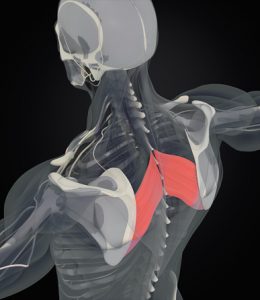
Excessive use of your arms and shoulders can easily lead to rhomboid pain. Playing sports like golf or tennis can overstretch the rhomboid muscles, causing them to feel pain and soreness. Carrying heavy loads on your upper back, as well as short bursts of abnormal movement, can elicit rhomboid muscle pain.
Overstretching of the rhomboid muscles can occur when isolating them during workouts, as they are a small group of muscles. When used alone and overworked, they have a greater tendency for tearing in comparison to other larger groups of muscles found in the body.
Rhomboid muscle strain can be frustrating and inhibit certain activities. Understanding the cause of the pain felt in this muscle group can help you prevent future instances of it.
What are the causes of Rhomboid Muscle Strain?
Most cases of rhomboid strain are due to overuse of the arms and shoulders. The following are various activities that may lead to rhomboid pain development:
- Poor posture: A lot of us have poor posture, like when we’re sitting at a desk for long periods of time.
- Overhead work: Reaching up to items on high shelves or having a job that requires this to be repeatedly done can put excessive stress on the rhomboid muscles.
- Carrying heavy backpacks: This can be particularly harmful to the rhomboid muscles if carried on one shoulder.
- Rowing: The forceful motion can put excessive amounts of stress on the rhomboid muscles
Symptoms related to rhomboid strain
Common symptoms of rhomboid muscle pain include:
- Muscle pain felt between the spine and shoulder blades
- Tightness, knots, or spasms in the rhomboid muscles
- Pain when breathing or moving the shoulders
- Tenderness or tightness in the upper back
- Pain in the upper back that increases with excessive movement
Diagnosing rhomboid strain
When seeing a doctor for your yet undiagnosed rhomboid muscle pain, they will ask you in detail where your pain is felt, what makes it worse, and what makes it better. This will give the doctor a better idea of where the pain is located. A brief medical history will also be taken to rule out any underlying causes.
The most obvious cause of rhomboid pain is an injury of some sort, so it’s important to tell your doctor if you play any sports or perform tasks at work that could have led to your rhomboid strain symptoms.
Next will be a physical exam. Your doctor will inspect the area, looking for any signs of bruising on the upper back. They will then ask you to move your arms and shoulders to see exactly how the rhomboid strain is produced and which areas of the upper back show tightness and tenderness.
Related: Treating rhomboid muscle pain: Exercises, remedies, and prevention tips